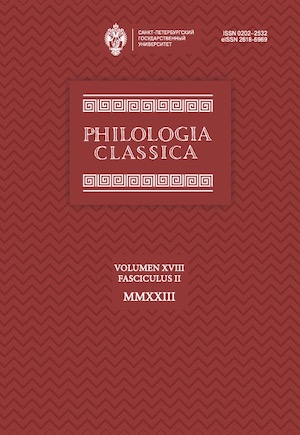What is a γρυπαίετος (Aesch. Fr. inc. fab. 422 R. )?
DOI:
https://doi.org/10.21638/spbu20.2023.203Abstract
The purpose of the following paper is to identify what kind of mythical creature Aeschylus’ γρυπαίετος (‘griffin–eagle’) that caused such a scandal for ‘Euripides’ in Aristophanes’ Frogs 928–930 (= Aesch. fr. inc. fab. 422 R.) was. The term has usually been interpreted in three ways: (a) as a poetic form of ‘eagle’; (b) as a poetic form of ‘griffin’; (c) as ‘eagle of the griffin species’. The testimony of Aristophanes’ Frogs and vase-painting suggests that it may have been an idiosyncratic, archaic type of griffin, called by modern specialists ‘griffin-bird’ and characterised by having two legs, not four, and the body of a bird, not a lion. This fantastic creature appeared quite frequently on Archaic black-figure vases in Athens, but had completely disappeared by the end of the 6th century BC. As a result, its appearance would be unknown to Aristophanes’ public, making the term γρυπαίετος impossible to make out (Ra. 930). Thus, the following paper suggests that Aeschylus’ γρυπαίετος (‘griffin-eagle’) is a fabulous composite beast made up of griffin and eagle parts, as its name suggests: a griffin head (with an open hooked beak, long pointed ears, a protuberance or horn over the eyes, and a curl or plume falling down one side of the neck) crowning an eagle body (two-legged, feathered, with wings and talons).
Keywords:
Aeschylus, Aristophanes, griffin, γρυπαίετος, griffin-eagle
Downloads
References
Downloads
Published
How to Cite
Issue
Section
License
Articles of "Philologia Classica" are open access distributed under the terms of the License Agreement with Saint Petersburg State University, which permits to the authors unrestricted distribution and self-archiving free of charge.






